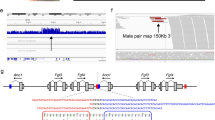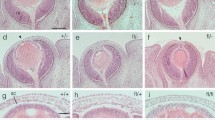Abstract
Normal fusion of developing eyelids requires coordination of inductive signals from the eyelid mesenchyme with migration of the periderm cell layer and constriction of the eyelids across the eye. Failure of this process results in an eyelids open at birth (EOB) phenotype in mice. We have identified a novel spontaneous allele of Alx4 that displays EOB, in addition to polydactyly and cranial malformations. Alx4 is expressed in the eyelid mesenchyme prior to and during eyelid fusion in a domain overlapping the expression of genes that also play a role in normal eyelid development. We show that Alx4 mutant mice have reduced expression of Fgf10, a key factor expressed in the mesenchyme that is required for initiation of eyelid fusion by the periderm. This is accompanied by a reduced number of periderm cells expressing phosphorylated c-Jun, consistent with the incomplete ablation of Fgf10 expression. Together, these data demonstrate that eyelid fusion in mice requires the expression of Alx4, accompanied by the loss of normal expression of essential components of the eyelid fusion pathway.






Similar content being viewed by others
References
Antonopoulou I, Mavrogiannis LA, Wilkie AO, Morriss-Kay GM (2004) Alx4 and Msx2 play phenotypically similar and additive roles in skull vault differentiation. J Anat 204:487–499
Beverdam A, Brouwer A, Reijnen M, Korving J, Meijlink F (2001) Severe nasal clefting and abnormal embryonic apoptosis in Alx3/Alx4 double mutant mice. Development 128:3975–3986
Byun TH, Kim JT, Park HW, Kim WK (2011) Timetable for upper eyelid development in staged human embryos and fetuses. Anat Rec 294:789–796
Forsthoefel PF (1963) The embryological development of the effects of strong’s luxoid gene in the mouse. J Morphol 113:427–451
Gao Y, Lan Y, Ovitt CE, Jiang R (2009) Functional equivalence of the zinc finger transcription factors Osr1 and Osr2 in mouse development. Dev Biol 328:200–209
Grose R (2003) Epithelial migration: open your eyes to c-Jun. Curr Biol 13:R678–R680
Heller E, Kumar KV, Grill SW, Fuchs E (2014) Forces generated by cell intercalation tow epidermal sheets in mammalian tissue morphogenesis. Dev Cell 28:617–632
Huang J, Dattilo LK, Rajagopal R, Liu Y, Kaartinen V, Mishina Y, Deng CX, Umans L, Zwijsen A, Roberts AB, Beebe DC (2009) FGF-regulated BMP signaling is required for eyelid closure and to specify conjunctival epithelial cell fate. Development 136:1741–1750
Kuijper S, Feitsma H, Sheth R, Korving J, Reijnen M, Meijlink F (2005) Function and regulation of Alx4 in limb development: complex genetic interactions with Gli3 and Shh. Dev Biol 285:533–544
Li C, Guo H, Xu X, Weinberg W, Deng CX (2001) Fibroblast growth factor receptor 2 (Fgfr2) plays an important role in eyelid and skin formation and patterning. Dev Dyn 222:471–483
Li G, Gustafson-Brown C, Hanks SK, Nason K, Arbeit JM, Pogliano K, Wisdom RM, Johnson RS (2003) c-Jun is essential for organization of the epidermal leading edge. Dev Cell 4:865–877
Luetteke NC, Qiu TH, Peiffer RL, Oliver P, Smithies O, Lee DC (1993) TGF alpha deficiency results in hair follicle and eye abnormalities in targeted and waved-1 mice. Cell 73:263–278
Mann GB, Fowler KJ, Gabriel A, Nice EC, Williams RL, Dunn AR (1993) Mice with a null mutation of the TGF alpha gene have abnormal skin architecture, wavy hair, and curly whiskers and often develop corneal inflammation. Cell 73:249–261
Martin P, Parkhurst SM (2004) Parallels between tissue repair and embryo morphogenesis. Development 131:3021–3034
Mazzalupo S, Coulombe PA (2001) A reporter transgene based on a human keratin 6 gene promoter is specifically expressed in the periderm of mouse embryos. Mech Dev 100:65–69
Meng Q, Mongan M, Carreira V, Kurita H, Liu C-Y, Kao W, Xia Y (2014) Eyelid closure in embryogenesis is required for ocular adnexa development. Invest Ophthamol Vis Sci 55:7652–7661
Murray SA, Gridley T (2006) Snail family genes are required for left-right asymmetry determination, but not neural crest formation, in mice. Proc Natl Acad Sci US Am 103:10300–10304
Qu S, Niswender KD, Ji Q, van der Meer R, Keeney D, Magnuson MA, Wisdom R (1997) Polydactyly and ectopic ZPA formation in Alx-4 mutant mice. Development 124:3999–4008
Qu S, Tucker SC, Ehrlich JS, Levorse JM, Flaherty LA, Wisdom R, Vogt TF (1998) Mutations in mouse aristaless-like4 cause strong’s luxoid polydactyly. Development 125:2711–2721
Qu S, Tucker SC, Zhao Q, deCrombrugghe B, Wisdom R (1999) Physical and genetic interactions between Alx4 and Cart1. Development 126:359–369
Schrewe H, Gendron-Maguire M, Harbison ML, Gridley T (1994) Mice homozygous for a null mutation of activin beta B are viable and fertile. Mech Dev 47:43–51
Sekine K, Ohuchi H, Fujiwara M, Yamasaki M, Yoshizawa T, Sato T, Yagishita N, Matsui D, Koga Y, Itoh N, Kato S (1999) Fgf10 is essential for limb and lung formation. Nat Genetics 21:138–141
Shimizu Y, Thumkeo D, Keel J, Ishizaki T, Oshima H, Oshima M, Noda Y, Matsumura F, Taketo MM, Narumiya S (2005) ROCK-I regulates closure of the eyelids and ventral body wall by inducing assembly of actomyosin bundles. J Cell Biol 168:941–953
Tao H, Shimizu M, Kusumoto R, Ono K, Noji S, Ohuchi H (2005) A dual role of FGF10 in proliferation and coordinated migration of epithelial leading edge cells during mouse eyelid development. Development 132:3217–3230
Threadgill DW, Dlugosz AA, Hansen LA, Tennenbaum T, Lichti U, Yee D, LaMantia C, Mourton T, Herrup K, Harris RC et al (1995) Targeted disruption of mouse EGF receptor: effect of genetic background on mutant phenotype. Science 269:230–234
Toonen J, Liang L, Sidjanin DJ (2012) Waved with open eyelids 2 (woe2) is a novel spontaneous mouse mutation in the protein phosphatase 1, regulator (inhibitor) subunit 13 like (Ppp1r13 l) gene. BMC Genet 13:76
Vassalli A, Matzuk MM, Gardner HA, Lee KF, Jaenisch R (1994) Activin/inhibin beta B subunit gene disruption leads to defects in eyelid development and female reproduction. Genes Dev 8:414–427
Xia Y, Kao WW (2004) The signaling pathways in tissue morphogenesis: a lesson from mice with eye-open at birth phenotype. Biochem Pharmacol 68:997–1001
Zenz R, Scheuch H, Martin P, Frank C, Eferl R, Kenner L, Sibilia M, Wagner EF (2003) c-Jun regulates eyelid closure and skin tumor development through EGFR signaling. Dev Cell 4:879–889
Zhang L, Wang W, Hayashi Y, Jester JV, Birk DE, Gao M, Liu CY, Kao WW, Karin M, Xia Y (2003) A role for MEK kinase 1 in TGF-beta/activin-induced epithelium movement and embryonic eyelid closure. EMBO J 22:4443–4454
Zieske JD (2004) Corneal development associated with eyelid opening. Int J Dev Biol 48:903–911
Acknowledgments
This work is supported by NIH Grants EY015073 (to L. R. D) and DE020052 (to S. M. and L. R. D.). The authors would like to thank Harold Coombs for assistance with colony maintenance and Aimee Picard and Kevin Peterson for their review and editing of the manuscript.
Author information
Authors and Affiliations
Corresponding author
Rights and permissions
About this article
Cite this article
Curtain, M., Heffner, C.S., Maddox, D.M. et al. A novel allele of Alx4 results in reduced Fgf10 expression and failure of eyelid fusion in mice. Mamm Genome 26, 173–180 (2015). https://doi.org/10.1007/s00335-015-9557-z
Received:
Accepted:
Published:
Issue Date:
DOI: https://doi.org/10.1007/s00335-015-9557-z




